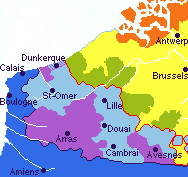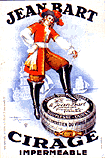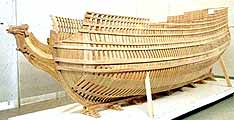|
Places to visit | Background information | Find a book about it |
|
|
Jean Bart- corsair of Dunkerque 1650-1702 |
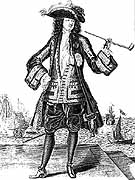 17th century corsair Jean Bart grew rich from prize money and royal rewards as he sunk ships and siezed cargoes from King Louis XIV's enemies |
Jean Bart's rise to
fame Born into a poor Flemish family of sailors in Dunkerque, Jean Bart went to sea at age12. When he was a boy, the English had besieged, battered and captured his home town - perhaps naturally, teenage Jean joined the Dutch Navy to fight the English. He observed brilliant Dutch admiral De Ruyter, and learnt seamanship and naval tactics. When France declared war on Holland in 1672, he returned home and joined up as a corsair. Dunkerque naval
base Colbert had established a naval dockyard with an arsenal, ropery, barracks, a sailors' hospital; dredged a deep channel to the port, and created a Royal Basin. Dunkerque was the base for the new Fleet du Nord. In Louis XIV's Marine Guard, the ships' captains and crews made money from "prizes". They attacked enemy ships, men and cargoes at sea, and if they could bring them back to Dunkerque, were rewarded with prize money. Were they just lawless pirates? Their defenders say not, because (like Sir Francis Drake in the days of England's Elizabeth I) they carried a licence from the King, and attacked only his enemies. |
|
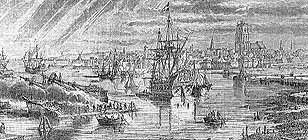 After buying Dunkerque, Louis XIV improved the harbour, and dredged a deep channel out to the North Sea. |
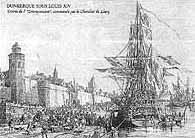 Dunkerque was a town of sailors: when a fighting ship returned, excited crowds rushed out of the walled town onto the dockside. |
|
Jean Bart's home
town In 1658, Dunkerque was encircled. At sea, the ships of dour English Puritan Oliver Cromwell blockaded the port. On land, English troops were joined in besieging the town by those of French "Sun King" Louis XIV, fighting for glory and the Catholic religion. When a Spanish army came to relieve the siege, they were beaten in the Battle of the Dunes. Part of the deal was that the captured town was handed over to the English - local people joke that Dunkerque was Spanish, French and English all in one day, but it was not funny at the time! |
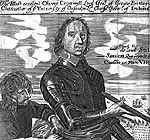 Oliver Cromwell - the English Navy blockaded Dunkerque in 1658, helping the French army under Turenne capture it from the Spanish. |
||||||||||||||||
|
1662: France gained a
North Sea naval base... ...and a town of brave, daring sailors |
|
||||||||||||||||
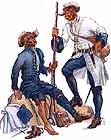   (L-R) soldiers of the Marine guard; an officer; and a captain. |
|||||||||||||||||
|
Dunkerque's sailors were keen to join up. Their town had been North Sea herring fishermen for centuries, but since the 14th century they had also taken to piracy - preying on passing merchant ships. The town had already gained a reputation as a remote lawless place in the sand-dunes. Jean Bart's success was attributed to Dunkerque's numerous population of sailors who provided courageous spirited officers and crews; also his own qualities as a bold dashing leader with a good tactical sense; and the support and organising skill of Colbert and the Naval Secretary of State, Louis de Ponchartrain who encouraged the corsairs to act as a disciplined fighting force. |
|||||||||||||||||
|
Fighting the Dutch
1672-78 1678: Fortifying the
corsiares' base |
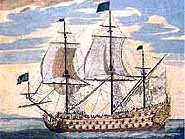 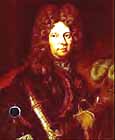 Jean Bart's ship - Contemporary portrait |
||||||||||||||||
|
1688-1694: Daring deeds
against stronger foes In 1689, Jean Bart's ship was escorting 20 French merchant vessels down the Channel. when they were attacked and captured by a much bigger Anglo-Dutch force. Jean Bart, his lieutenant Claude de Forbin and 20 men were imprisoned in Plymouth. They escaped, stole a boat and were back in France in 2 days! |
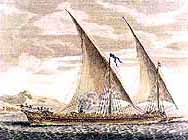 Jean Bart's new fleet had manouverable shallow-draft boats that could cross the sandbanks along the coast - firing guns and boarding English, Dutch and Spanish ships that had to keep to the channels leading to the ports. |
||||||||||||||||
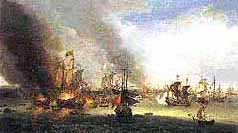 Battle: in 1694 Jean Bart saved Paris from starving, by capturing a huge fleet of 150 ships carrying grain from the Baltic to Holland. As a reward, Louis XIV made Jean Bart a noble, and made his 14 year-old son François Bart a marine guard. |
|||||||||||||||||
|
Louis entrusted Jean Bart with a fleet of light vessels which could skim over the shallow sands of the south North Sea, attacking English and Dutch ships with great success. In vain they tried to stop him by blockading Dunkerque - even twice (1694-5) bombarding the town. 1696-1702: In command |
|||||||||||||||||
|
The end of Dunkerque as a
nest of pirates The town was made into a desert, and the desperate inhabitants turned their seafaring skills back to deep-sea fishing. They built up the risky trade of sailing out to the North Sea cod shoals around Iceland - see 'Fishing". |
|||||||||||||||||
|
|
Jean Bart - hero of
Dunkerque |
|
|
Plans for a Maritime
Heritage Park The Tourville association has already achieved a prototype model (pictured RIGHT) based on Colbert's naval dictionary, and archeological diving in the Channel off Cherbourg, which discovered six 17th century wrecks - part of Admiral Tourville's fleet whose mission was to restore James II to the English throne. A feasibility study of the Heritage Park estimates it could attract up to 400,000 visitors annually. |
|
|
|
||||
|
Places to
visit: |
||||
|
Related background
information |
|
|
|
|
|


